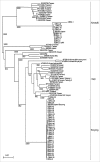Phylogenetic analysis of the 56-kDa type-specific protein genes of Orientia tsutsugamushi in Central Korea
- PMID: 23166411
- PMCID: PMC3492664
- DOI: 10.3346/jkms.2012.27.11.1315
Phylogenetic analysis of the 56-kDa type-specific protein genes of Orientia tsutsugamushi in Central Korea
Abstract
There are several antigenic variants of Orientia tsutsugamushi. The 56-kDa type-specific antigen (TSA) is responsible for the antigenic variation. Nucleotide sequences of the 56-kDa TSA obtained from 44 eschar samples of Korean scrub typhus patients and from 40 representative strains retrieved from the GenBank database were analyzed phylogenetically. Clinical patient data were assessed based on the genotyping results. Of the 44 nucleotide sequences, 32 (72.7%) clustered with the Boryong genotype, which is the major genotype in Korea. Eleven nucleotide sequences (25%) clustered with the Kawasaki genotype, not identified in Korea until 2010. One nucleotide sequence was consistent with the Karp genotype. The clinical course of the patients infected with each genotype showed no differences. Diagnostic performance of the immunofluorescence assay (IFA) using the 56-kDa TSA from Gilliam, Karp and Boryong as test antigens were not different for the Boryong and Kawasaki genotypes. Although Boryong is still the predominant genotype, the results suggest that Kawasaki genotype is quite prevalent in Chungbuk province of Korea.
Keywords: 56-kDa Type-Specific Antigen; Boryong Genotype; Kawasaki Genotype; Orientia tsutsugamushi.
Figures



Similar articles
-
Phylogenetic analysis of the 56 kDa protein genes of Orientia tsutsugamushi in Southwest Area of Korea.Am J Trop Med Hyg. 2011 Feb;84(2):250-4. doi: 10.4269/ajtmh.2011.09-0601. Am J Trop Med Hyg. 2011. PMID: 21292894 Free PMC article.
-
Use of eschar swabbing for the molecular diagnosis and genotyping of Orientia tsutsugamushi causing scrub typhus in Quang Nam province, Vietnam.PLoS Negl Trop Dis. 2017 Feb 27;11(2):e0005397. doi: 10.1371/journal.pntd.0005397. eCollection 2017 Feb. PLoS Negl Trop Dis. 2017. PMID: 28241043 Free PMC article.
-
Representative Genotyping, Recombination and Evolutionary Dynamics Analysis of TSA56 Gene Segment of Orientia tsutsugamushi.Front Cell Infect Microbiol. 2020 Aug 5;10:383. doi: 10.3389/fcimb.2020.00383. eCollection 2020. Front Cell Infect Microbiol. 2020. PMID: 32903648 Free PMC article.
-
Scrub typhus: the geographic distribution of phenotypic and genotypic variants of Orientia tsutsugamushi.Clin Infect Dis. 2009 Mar 15;48 Suppl 3:S203-30. doi: 10.1086/596576. Clin Infect Dis. 2009. PMID: 19220144 Review.
-
Orientia tsutsugamushi DNA load and genotypes in blood as a marker of severity.Acta Trop. 2021 Mar;215:105786. doi: 10.1016/j.actatropica.2020.105786. Epub 2020 Dec 9. Acta Trop. 2021. PMID: 33309595 Review.
Cited by
-
Genotypic characterization of Orientia tsutsugamushi from patients in two geographical locations in Sri Lanka.BMC Infect Dis. 2017 Jan 13;17(1):67. doi: 10.1186/s12879-016-2165-z. BMC Infect Dis. 2017. PMID: 28086810 Free PMC article.
-
A Review of Scrub Typhus (Orientia tsutsugamushi and Related Organisms): Then, Now, and Tomorrow.Trop Med Infect Dis. 2018 Jan 17;3(1):8. doi: 10.3390/tropicalmed3010008. Trop Med Infect Dis. 2018. PMID: 30274407 Free PMC article. Review.
-
Molecular epidemiology of scrub typhus in Taiwan during 2006-2016.PLoS Negl Trop Dis. 2022 Apr 29;16(4):e0010369. doi: 10.1371/journal.pntd.0010369. eCollection 2022 Apr. PLoS Negl Trop Dis. 2022. PMID: 35486655 Free PMC article.
-
Molecular Epidemiology of an Orientia tsutsugamushi Gene Encoding a 56-kDa Type-Specific Antigen in Chiggers, Small Mammals, and Patients from the Southwest Region of Korea.Am J Trop Med Hyg. 2018 Feb;98(2):616-624. doi: 10.4269/ajtmh.17-0070. Epub 2018 Jan 4. Am J Trop Med Hyg. 2018. PMID: 29313468 Free PMC article.
-
Molecular Epidemiology and Genetic Diversity of Orientia tsutsugamushi From Patients and Small Mammals in Xiangyun County, Yunnan Province, China.Vet Med Sci. 2025 Sep;11(5):e70573. doi: 10.1002/vms3.70573. Vet Med Sci. 2025. PMID: 40833348 Free PMC article.
References
-
- Ree HI, Cho MK, Lee IY, Jeon SH. Comparative epidemiological studies on vector/reservoir animals of tsutsugamushi disease between high and low endemic areas in Korea. Korean J Parasitol. 1995;33:27–36. - PubMed
-
- Tamura A, Takahashi K, Tsuruhara T, Urakami H, Miyamura S, Sekikawa H, Kenmotsu M, Shibata M, Abe S, Nezu H. Isolation of Rickettsia tsutsugamushi antigenically different from Kato, Karp, and Gilliam strains from patients. Microbiol Immunol. 1984;28:873–882. - PubMed
-
- Murata M, Yoshida Y, Osono M, Ohashi N, Oyanagi M, Urakami H, Tamura A, Nogami S, Tanaka H, Kawamura A., Jr Production and characterization of monoclonal strain-specific antibodies against prototype strains of Rickettsia tsutsugamushi. Microbiol Immunol. 1986;30:599–610. - PubMed
-
- Elisberg BL, Campbell JM, Bozeman FM. Antigenic diversity of rickettsia tsutsugamushi: epidemiologic and ecologic significance. J Hyg Epidemiol Microbiol Immunol. 1968;12:18–25. - PubMed
MeSH terms
Substances
LinkOut - more resources
Full Text Sources
Research Materials

